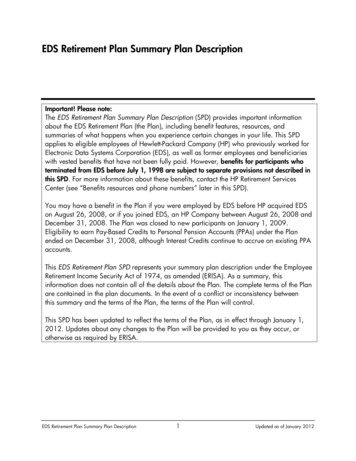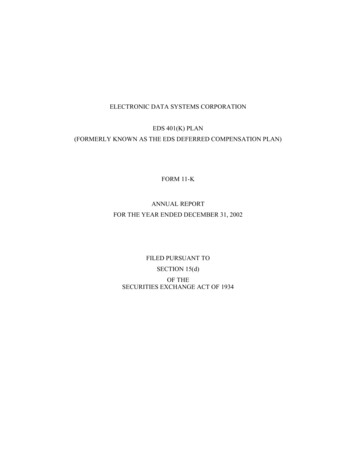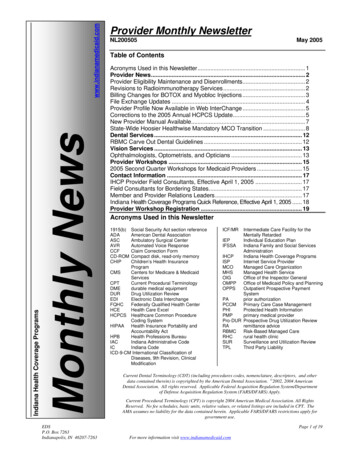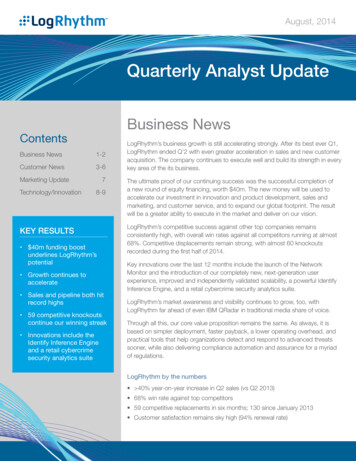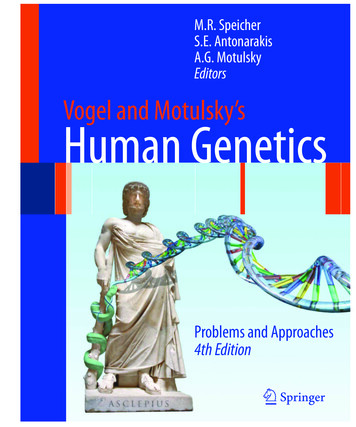
Transcription
Speicher · AntonarakisM.R. SpeicherS.E. AntonarakisA.G. MotulskyEditorsVogel and Motulsky’sHuman Genetics1Vogel and Motulsky’sEd.Problems and Approaches4th Edition1 23
Speicher Antonarakis Motulsky VOGEL AND MOTULSKY’S HUMAN GENETICSProblems and ApproachesFourth Edition
SpeicherAntonarakisMotulskyVOGEL AND MOTULSKY’SHUMAN GENETICSProblems and ApproachesFourth, Completely Revised EditionWith 343 Figures and 76 Tables
EditorsMichael R. SpeicherInstitute of Human GeneticsMedical University of GrazHarrachgasse 21/88010 GrazAustriamichael.speicher@medunigraz.atStylianos E. AntonarakisDepartment of Genetic Medicine and DevelopmentUniversity of Geneva Medical Schooland University Hospitals of Geneva1 rue Michel-Servet1211 o G. MotulskyProfessor EmeritusDepartments of Medicine (Division of Medical Genetics)and Genome SciencesUniversity of WashingtonSchool of MedicineBox 3550651705 N.E. Pacific St.Seattle, WA 98195-5065USAagmot@u.washington.eduISBN 978-3-540-37653-8e-ISBN 978-3-540-37654-5DOI 10.1007/978-3-540-37654-5Springer Heidelberg Dordrecht London New YorkLibrary of Congress Control Number: 2009931325 Springer-Verlag Berlin Heidelberg 2010This work is subject to copyright. All rights are reserved, whether the whole or part of the material is concerned, specifically the rights oftranslation, reprinting, reuse of illustrations, recitation, broadcasting, reproduction on microfilm or in any other way, and storage in databanks. Duplication of this publication or parts thereof is permitted only under the provisions of the German Copyright Law of September 9,1965, in its current version, and permission for use must always be obtained from Springer. Violations are liable to prosecution under theGerman Copyright Law.The use of general descriptive names, registered names, trademarks, etc. in this publication does not imply, even in the absence of a specificstatement, that such names are exempt from the relevant protective laws and regulations and therefore free for general use.Cover design: Estudio Calamar, SpainPrinted on acid-free paperSpringer is part of Springer Science Business Media (www.springer.com)
In memory of Friedrich VogelThe editorsTo my wife, Irene, and our children,Alexander and Julia.Michael R. SpeicherTo my parents, my wife, Grigoria, andour children.Stylianos E. AntonarakisTo the memory of my wife, Gretel, andto my children.Arno G. Motulsky
PrefaceThe first edition of Human Genetics, Problems and Approaches, was published in1970 by human geneticists Friedrich Vogel and Arno Motulsky as sole authors. Theaim was broad coverage and in-depth analysis of both medical and human geneticswith an emphasis on problems and approaches with occasional historical comments. This point of view was fully explained in an introductory chapter of the threeprevious editions (1970, 1976, 1997). The book acquired an excellent reputation asan advanced text of human genetics and has been translated into Italian, Japanese,Russian, Chinese, and Portuguese. Our general aims for the fourth edition remainsimilar and together with novel developments are now set out in the Introduction ofthis new fourth edition.Around 2004/2005, both Friedrich Vogel and Arno Motulsky, as well as thepublishers, felt that the book should be continued with a new fourth edition in thesame spirit and coverage as earlier editions, but should now include additionalexpert authors. After some delay and the death of Friedrich Vogel in the summerof 2006, a new editorial team consisting of Michael R. Speicher of the MedicalUniversity of Graz, Austria, Stylianos E. Antonarakis of the University of GenevaMedical School, and Arno G. Motulsky of the University of Washington Schoolof Medicine, was constituted for the fourth edition of the Vogel/Motulsky book inthe spirit of the original work.An outline of the fourth edition’s contents was developed and variousinternationally known geneticists, including the new editors, were selected to writethe individual chapters. The resultant titles are listed in the table of contents. Mostchapters are entirely new, while only three chapters (1, 5, and 6) utilize the thirdedition with appropriate, up-to-date revisions. Entirely new chapters include thedescription of the human genome, epigenetics, pharmacogenetics, geneticepidemiology, human evolution, genetics of mental retardation, autism, alcoholismand other addictions, consanguinity and related matters, gene therapy, cloning andgenetic aspects of global health. Multiple chapters of various animal models usedin the study of human and medical genetics are novel as are Databases and GenomeBrowsers as well as Databases Used in Human and Medical Genetics. The finalcontent of the book was the result of many e-mails and conference calls. This new,updated, and totally revised edition does not contain some important andhistorically interesting chapters on certain topics. These can be found in the thirdedition of the book published in 1997, which was exclusively authored by F. Vogeland A.G. Motulsky. These topics were: enzymes in Chap. 7 (pp. 258–299); mutationrates in Chap. 9 (pp. 393–413); and mutation induction by ionizing radiation andchemicals in Chap. 11 (pp. 457–493).vii
viiiPrefaceThe staff of Springer was most helpful in giving us extensive and firm aid ingetting the book finished. We thank particularly Doris M. Binzenhöfer-Walker forher work during the early stage of the project and Isabella Athanassiou for herefficient help later. Andrea Pillman was a strict task mistress, who encouraged usto finish the book expeditiously.The editors of the fourth edition want to express their intellectual indebtednessto Friedrich Vogel for having conceived of and played a major role in the firstthree editions of this book. Arno Motulsky particularly misses his discussionswith Friedrich on human genetics and its role in science and medicine.The cover illustration portrays a marble statue of Asclepius, the Greek god ofhealing, grasping a serpent-encircled staff as a symbol of medicine. The doublehelix of DNA joined to Asclepius symbolizes the applications of basic geneticsto medicine.4th editionJune 28, 2009Michael R. Speicher, GrazStylianos E. Antonarakis, GenevaArno G. Motulsky, Seattle
Preface to the First EditionHuman genetics provides a theoretical framework for understanding the biology ofthe human species. It is a rapidly growing branch of science. New insights into thebiochemical basis of heredity and the development of human cytogenetics in the1950s heightened interest in this field. The number of research workers and clinicians who define themselves as full-time or part-time human and medical geneticists has increased sharply, and detailed well-founded knowledge has augmentedexponentially. Many scientists and physicians are confronted with genetic problems and use concepts and methodology of human genetics in research and diagnosis. Methods developed in many different fields of the biologic, chemical, medical,and statistical sciences are being utilized toward the solution of genetic problems.The increasing number and sophistication of well-defined and elegantly solvedproblems helps to refine an extensive framework of genetic theory. These new conceptual insights in their turn lead to solutions of new questions. To mention onlyone example, the structure of hemoglobin genes has been elucidated using methodsderived from protein chemistry and DNA technology. It is an exciting experience toparticipate in these developments!Moreover, scientific progress in genetics has practical implications for humanwell-being. Improved knowledge of the genetic cause of an increasing number ofhuman diseases helps to refine diagnosis, to find new therapeutic approaches, andabove all, to prevent genetic diseases. So far, human genetics has had less of animpact on the behavioral and social sciences. It is possible that genetic differencesinvolved in shaping personality structure, cognitive faculties, and possibly humansocial behavior may be at least as important as genetic variation affecting healthand disease. The data, however, are less clear and more controversial. These problems are discussed in detail in the text. The rapid progress of human genetics inrecent decades has attracted – and is still attracting – an increasing number of students and scientists from other fields. Various elementary textbooks, more advancedmonographs of various branches of the field, and the original journal literature arethe usual sources of introduction to human genetics. What seems to be lacking,however, is a fairly thorough and up-to-date treatise on the conceptual basis of theentire field of human genetics and its practical applications. Often, the absence of abroadly based background in the field leads to misunderstanding of its scope,unclear goals for research, improper selection of methods, and imbalanced theoretical discussions. Human genetics is based on a powerful theory, but this implicitconceptual foundation should be made explicit. This goal is the purpose of thisbook. It certainly is a formidable and possibly even too audacious task for two soleauthors. However, both of us have been active in the field for more than 25 years.ix
xPreface to the First EditionWe have worked on various problems and with a variety of methods. Since the earlyyears of our careers, we have met occasionally, followed each other’s writings, andwere often surprised by the similarity of our opinions and judgments despite quitedifferent early medical and scientific backgrounds. Moreover, our knowledge of theliterature turned out to be in part overlapping and in part complementary. Since weare working in different continents, AGM had a better knowledge of concepts andresults in the USA, while FV knew more of the continental European literature.Moreover, both of us have extensive experience as editors of journals in humangenetics and one (FV) published a fairly comprehensive textbook in Germany sometime ago (Lehrbuch der allgemeinen Humangenetik, Springer 1961), parts of whichwere still useful for the new book. We finally decided to take the risk, and, by writing an “advanced” text, to expose our deficiencies of knowledge, shortcomings ofunderstanding, and biases of judgment.A text endeavoring to expose the conceptual framework of human genetics cannot be dogmatic and has to be critical. Moreover, we could not confine ourselves tohard facts and well-proved statements. The cloud of conjectures and hypothesessurrounding a rapidly growing science had to be depicted. By doing so, we face therisk of being disproved by further results.A number of colleagues helped by reading parts of the manuscript on which theyhad expert knowledge and by making useful suggestions: W. Buselmaier, U. Ehling,G. Flatz, W. Fuhrmann, S. Gartler, Eloise Giblett, P. Propping, Laureen Resnick,and Traute M. Schroeder. They should not be held responsible for possible errors.J. Krüger was of supreme help in the statistical parts. Our secretaries, Mrs. AdelheidFengler and Mrs. Gabriele Bauer in Heidelberg, Mrs. Sylvia Waggoner in Seattle,and Mrs. Helena Smith in Stanford gave invaluable aid. The figures were drawn byEdda Schalt and Marianne Lebküchner. Miriam Gallaher and Susan Peters did anexpert job of copy editing. The authors are especially grateful to Dr. Heinz Götzeand Dr. Konrad F. Springer, of Springer Publishing Company, for the excellent production. The work could not have been achieved had the two authors not beeninvited to stay at the Center for Advanced Study in the Behavioral Sciences atStanford (California) for the academic year of 1976/1977. The grant for AGM waskindly provided by the Kaiser Family Foundation, while the Spencer Foundationdonated the grant for FV.The cover of this book shows the mythical first human couple, Adam and Eve, asimagined by Albrecht Dürer (1504). They present themselves in the full beauty oftheir bodies, ennobled by the genius and skill of a great artist. The drawing shouldremind us of the uniqueness and dignity of the human individual. Human geneticscan help us to understand humanity better and to make human life happier. This science is a cardinal example of Alexander Pope’s statement. “The proper study ofmankind is man.”Spring 1979Friedrich Vogel, HeidelbergArno G. Motulsky, Seattle
Contents OverviewIntroduction .11History of Human Genetics .Arno G. Motulsky132Human Genome Sequence and Variation .Stylianos E. Antonarakis313Chromosomes.Michael R. Speicher554From Genes to Genomics to Proteomics . 139Michael R. Speicher5Formal Genetics of Humans: Modes of Inheritance . 165Arno G. Motulsky6Linkage Analysis for Monogenic Traits. 211Arno G. Motulsky and Michael Dean7Oligogenic Disease . 243Jon F. Robinson and Nicholas Katsanis8Formal Genetics of Humans: Multifactorial Inheritanceand Common Diseases . 263Andrew G. Clark8.1Lessons from the Genome-Wide Association Studiesfor Complex Multifactorial Disorders and Traits . 287Jacques S. Beckmann and Stylianos E. Antonarakis9Epigenetics . 299Bernhard Horsthemke10Human Gene Mutation: Mechanismsand Consequences . 319Stylianos E. Antonarakis and David N. Cooper11Human Hemoglobin . 365George P. Patrinos and Stylianos E. Antonarakisxi
xiiContents Overview12Human Genetics of Infectious Diseases . 403Alexandre Alcaïs, Laurent Abel, and Jean-Laurent Casanova13Gene Action: Developmental Genetics . 417Stefan Mundlos14Cancer Genetics . 451Ian Tomlinson15The Role of the Epigenome in Human Cancers. 471Romulo Martin Brena and Joseph F. Costello16Population Genetic Principles and Human Populations . 487Emmanouil T. Dermitzakis17Consanguinity, Genetic Drift, and Genetic Diseasesin Populations with Reduced Numbers of Founders . 507Alan H. Bittles18Human Evolution . 529Michael Hofreiter19Comparative Genomics . 557Ross C. Hardison20Genetics and Genomics of Human Population Structure . 589Sohini Ramachandran, Hua Tang, Ryan N. Gutenkunst,and Carlos D. Bustamante21Genetic Epidemiology . 617Sophia S. Wang , Terri H. Beaty, and Muin J. Khoury22Pharmacogenetics . 635Nicole M. Walley, Paola Nicoletti, and David B. Goldstein23Behavioral Genetics . 64923.1The Genetics of Personality . 651Jonathan Flint and Saffron Willis-Owen23.2Mental Retardation and Intellectual Disability . 663David L. Nelson23.3Genetic Factors in Alzheimer Disease and Dementia . 681Thomas D. Bird23.4Genetics of Autism . 699Brett S. Abrahams and Daniel H. Geschwind23.5The Genetics of Alcoholism and Other Addictive Disorders . 715David Goldman and Francesca Ducci23.6Behavioral Aspects of Chromosomal Variants . 743Michael R. Speicher
Contentsxiii23.7Genetics of Schizophrenia and Bipolar Affective Disorder . 759Markus M. Nöthen, Sven Cichon, Christine Schmael,and Marcella Rietschel24Model Organisms for Human Disorders . 777Michael R. Speicher24.1Mouse as a Model for Human Disease . 779Antonio Baldini24.2Caenorhabditis elegans, A Simple Worm: Bridgingthe Gap Between Traditional and Systems-Level Biology . 787Morgan Tucker and Min Han24.3Drosophila as a Model for Human Disease . 795Ruth Johnson and Ross Cagan24.4Human Genetics and the Canine System. 813Heidi G. Parker and Elaine A. Ostrander24.5Fish as a Model for Human Disease . 827Siew Hong Lam and Zhiyuan Gong25Genetic Counseling and Prenatal Diagnosis . 845Tiemo Grimm and Klaus Zerres26Gene Therapy . 867Vivian W. Choi and R. Jude Samulski27Cloning in Research and Treatment of HumanGenetic Disease . 875Ian Wilmut, Jane Taylor, Paul de Sousa, Richard Anderson,and Christopher Shaw28Genetic Medicine and Global Health . 885David J. Weatherall29Genetic Databases . 903Introductory Note by Stylianos E. Antonarakis29.1Databases and Genome Browsers . 905Rachel A. Harte, Donna Karolchik, Robert M. Kuhn, W. James Kent,and David Haussler29.2Ensembl Genome Browser. 923Xosé M. Fernández and Ewan Birney29.3Databases in Human and Medical Genetics . 941Roberta A. Pagon, Ada Hamosh, Johan den Dunnen,Helen V. Firth, Donna R. Maglott, Stephen T. Sherry,Michael Feolo, David Cooper, and Peter StensonSubject Index . 961Contents
ContentsIntroduction .11History of Human Genetics .Arno G. Motulsky131.11.21.31.41.51.6The Greeks (see Stubbe [83]) .Scientists Before Mendel and Galton .Galton’s Work .Mendel’s Work .Application to Humans: Garrod’s Inborn Errors of Metabolism .Visible Transmitters of Genetic Information:Early Work on Chromosomes .Early Achievements in Human Genetics .AB0 and Rh Blood Groups .Hardy-Weinberg Law.Developments Between 1910 and 1930.Human Genetics, the Eugenics Movement, and Politics .United Kingdom and United States .Germany.Soviet Union/Russia (see Harper, Chap. 16 in [38]) .Human Behavior Genetics .Development of Medical Genetics (1950 the Present) .Genetic Epidemiology .Biochemical Methods .Genetic and Biochemical Individuality .Cytogenetics, Somatic Cell Genetics, Prenatal Diagnosis.DNA Technology in Medical Genetics .The “Industrialization” of Discoveries and the Team Efforts .Unsolved Problems .References.14151617182Human Genome Sequence and Variation .Stylianos E. Antonarakis312.12.1.1The Human Genome .Functional Elements 2323232324242425262627xv
sProtein-Coding Genes .Noncoding, RNA-Only Genes .Regions of Transcription Regulation .Conserved Elements Not Included in the Above Categories .Repetitive Elements .Segmental Duplications .Special Genomic Structures Containing Selected Repeats .Mitochondrial Genome .Genomic Variability .Single Nucleotide Polymorphisms .Short Sequence Repeats .Insertion/Deletion Polymorphisms (Indels) .Copy Number Variants .Inversions .Mixed Polymorphisms .Genome Variation as a Laboratory Tool to Understandthe Genome omosomes .MIchael R. Speicher553.13.1.13.1.23.1.33.1.4History and Development of Human Cytogenetics .First Observations on Human Mitotic Chromosomes .An Old Error is Corrected and a New Era Begins .Birth of Human Cytogenetics 1956–1963 .Introduction of Banding Technologies from the Late1960s to the Present .The Birth of Molecular Cytogenetics in the Late 1960s.Molecular Cytogenetics or Fluorescence In SituHybridization 1980 to Date .Array Technologies: New Dimensions in Resolutionfrom 1997 to Date .Organization of Genetic Material in Human Chromosomes .Heterochromatin and Euchromatin .From DNA Thread to Chromosome Structure .DNA Condensation .Histone Modifications Organize Chromosomal Subdomains.Chromatin Diseases .Centromeres and Kinetochores .Function of Centromeres .Structure of Centromeres .Centromeres and Human Diseases .Chromosome Bands .G- and R-bands .In Silico-Generated Bands .Telomeres .Structure of Telomeres (Loop and Proteins) .The Telomere Replication Problem 656568686869
Telomerase .Telomeres and Human Diseases .Cell Cycle and Mitosis.Cell Cycle: Interphase G1-G2 and G0 .Cell Cycle: Mitosis .Mitosis and Cytokinesis .Prophase .Prometaphase .Metaphase .Anaphase.Telophase .Cytokinesis .Cell Cycle Checkpoints .Presently Known Checkpoints .The Spindle-Assembly Checkpoint in Detail .“Cohesinopathies,” Cornelia de Lange and Robert Syndrome .Possible Additional Checkpoints .Checkpoint Failures and Human Diseases.Cell Cycle Coordinators .Chromosome Analysis Methods .Banding Techniques.Preparation of Mitotic Metaphase Chromosomes .G-Bands .R-Bands .C-Bands .Ag-NOR Bands .DA/DAPI Staining .Karyotype Description .Normal Human Karyotype in Mitotic MetaphaseChromosomes .Description of Normal Human Karyotypes andKaryotypes with Numerical and Structural Changes.Fragile Sites .Fluorescence In Situ Hybridization .FISH to Metaphase Spreads.Interphase FISH (Interphase Cytogenetics) .Fiber FISH .Detection of Copy Number Changes in the Genome .Other Array-Based Methods .Meiosis .Biological Function of Meiosis .Meiotic Divisions .Meiotic Recombination Hotspots .Differences Between Male and Female Meiosis .Meiosis in the Human Male .Meiosis in the Human Female .A Dynamic Oocyte Pool? .Maternal Age and 697
nallelic Homologous Recombination DuringMeiosis Can Cause Microdeletion/Microduplication Syndromes .Molecular Mechanisms Involved in Meiosis .Human Chromosome Pathology in Postnatal Diagnostics .Syndromes
Medical School, and Arno G. Motulsky of the University of Washington School of Medicine, was constituted for the fourth edition of the Vogel/Motulsky book in the spirit of the original work. An outline o
